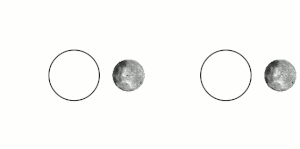Image: Getty
On Sunday night the China National Space Administration launched a communications satellite on a Long March rocket on a 280,000 mile journey to orbit the moon. The lunar orbiter is the initial step in realizing China’s ambition to be the first country to place a lander on the far side of the moon.As the first communications relay satellite in orbit around the moon, the orbiter’s name, Queqiao, is fitting. It translates to Magpie Bridge, a reference to the birds in a Chinese folk tale who form a bridge once per year to unite two separated lovers. Like the magpies in the story, the Queqiao orbiter will act as a link between the Chang’e-4 lunar lander planned to launch to the far side of the moon later this year and communications stations on Earth.Even though the moon does rotate, the same side always faces the Earth because the amount of time it takes for the moon to rotate on its axis is the same amount of time it takes to make a full orbit around the Earth, as seen on the left below: This phenomenon, known as tidal locking, means that the Chang’e-4 lander on the far side of the moon will never be able to make direct radio contact with Earth. Instead, the lander must rely on the Queqiao communications relay satellite in orbit around the moon to pass on its messages.The Queqiao orbiter is also carrying an antenna jointly developed with the Netherlands Institute for Radio Astronomy that will be deployed in orbit nearly 40,000 miles behind the moon. The antenna will be used to study star formation shortly after the Big Bang by looking at low frequency signals that are hard to detect from Earth due to interference from the atmosphere.
This phenomenon, known as tidal locking, means that the Chang’e-4 lander on the far side of the moon will never be able to make direct radio contact with Earth. Instead, the lander must rely on the Queqiao communications relay satellite in orbit around the moon to pass on its messages.The Queqiao orbiter is also carrying an antenna jointly developed with the Netherlands Institute for Radio Astronomy that will be deployed in orbit nearly 40,000 miles behind the moon. The antenna will be used to study star formation shortly after the Big Bang by looking at low frequency signals that are hard to detect from Earth due to interference from the atmosphere.
Advertisement

When the Chang’e-4 lander launches to the lunar surface later this year, it will carry silkworms and potato seeds, as well as an array of scientific instruments. It is part of a wider exploratory effort by the Chinese Space Agency, which hopes to establish a lunar “palace” on the south pole of the moon in the 2030s.The launch of Queqiao caps off a big few months for the Chinese space exploration as the nation vies to become the “space flight superpower” envisioned by its president Xi Jinping. Last year, the China National Space Administration used its quantum satellite to send the first entangled photons from space to Earth. Earlier this month, the first rocket designed by a private Chinese company was launched in an effort to claim a chunk of the orbital delivery market currently dominated by US companies like SpaceX.
China’s ramped up space program has led to increased calls in the United States to bolster its space warfare abilities. The Trump administration has made its desire for a “space force” well known and the Department of Defense is spending heavily on training members of the military for orbital combat.As the US adopts a defensive posture, the rest of the world seems to be embracing China’s bid to become a space superpower. The European Space Agency is courting China for rides to space on its rockets and has discussed plans for collaborating on the moon base together. Russia’s space agency, Roscosmos, is also on good terms with the China National Space Administration and the two space agencies have discussed lots of cooperative missions. NASA, meanwhile, is prohibited by law from collaborating with China.At a time when the Trump administration is looking to kill some of NASA’s most ambitious science programs, it’s hard not to be a little jealous of China’s determination to push the boundaries of space exploration.Read More: Space Wars Will Be Fought With Hacks, Not Missiles
